Springtime is ideal for gathering and enjoying lots of Stinging Nettles (Urtica dioica)
By late February I begin craving all sorts of spring greens but none so much as the intensely green and deeply nourishing Nettles. I have a fair-sized patch, started from seed many seasons ago, ringing an old Maple tree just outside our back door. Since we live on a stony ridge with maniacally good drainage, I tried to mimic the bottom land, shadier, moister spot that Nettles prefers. Sometimes I think I need not have bothered because it seems to pop up here and there all over our property, sometimes in a richer garden bed, sometimes in a dusty, shale bank that receives almost no rain. Obviously, Nettles adapts.
I remember learning about Nettles from herbalist and master storyteller Doug Elliot, while on a plant walk. He pointed out that delicious and nourishing plants had to develop some way to protect themselves to avoid being gobbled up by hungry animals (including humans). Some plants do this with bitter alkaloids that don’t taste so good, but Nettles achieved a degree of protection with their characteristic stinging hairs, which contain compounds that cause an uncomfortable, but harmless, tingle when we brush any exposed skin across them. Stingers and thorns are sometimes an indication of an excellent food plant. In the case of Nettles, it’s worth donning long sleeves and gloves and bringing along some kitchen shears to respectfully harvest her generous bounty. Make sure to leave plenty for the Red Admiral butterfly larvae and other pollinators.
Nettles has an intensely “green” taste, reminiscent of Spinach but with more attitude. The leaves are vitamin and mineral packed, which may account for the energy boost they bring. You may not feel it if you use the standard measure of a teaspoon of dried leaves to a cup of boiling water, however. If I’m feeling run down, I like to brew a strong infusion by placing ½ cup to 1 cup of dried leaves in a quart jar and covering it with boiled water to the rim, allowing it to steep covered for 3 or 4 hours. I consume this strained but unsweetened in “shots” of a couple of ounces each throughout the day. It’s strong, rather like an espresso shot, but there is a definite uptick in energy without any caffeine. Personally, I enjoy this strong brew, but if it’s not your cup of tea there are plenty of ways to prepare fresh Nettles in delicious foods.
Traditionally, Nettles is said to be “ruled” by Mars and is elementally a Fire plant. It might be more accurate to say that the energy of the plant has an affinity for things we associate with the red planet and the element of Fire. You’ll get that right away if you brush your bare skin past it and instantly get the tingly burn the stingers offer up, and the spot will probably redden quickly. You can use Dock leaves to stop the sensation, according to the old saying: Nettles in, Dock out! I’ve tried it and it worked for me. Nettles is a good blood builder, excellent for anemia, or general sluggishness. Modern research reveals that it works well not only as a kidney tonic but also strengthens the adrenal glands, which might also account for its energizing effect.
I find it interesting that my Nettles patch always starts growing in earnest when the sun enters the sign of Aries, also traditionally ruled by the planet Mars. Both the zodiac sign and the Nettle plant are known for showing up boldly, without apology, and making their presence known in no uncertain terms. They’re uncompromising and have a lot to teach us about taking charge of our own lives and setting clear boundaries. Reach in and yank a handful of Nettles once and you’ll soon learn not to repeat that disrespectful behavior.
Just a few of the benefits and charms of Nettles from my herb journal.
Hippocrates, Father of Medicine, is quoted as saying, “Let food be thy medicine, and medicine be thy food.” A key ingredient for health and vitality, as well as culinary excellence, is plenty of Nettles (Urtica dioica). I’m convinced that supporting our health via the foods and beverages we choose to eat and drink is the ideal way to “take our medicine.” Consuming vitamins and minerals, along with other constituents like fiber and flavonoids in delicious dishes shared with friends and family far outshines lying in a lonely sickbed, taking bitter pills and preparations. Here are a couple of family favorites in our home. No spoonful of sugar is needed to swallow these tasty “medicinal” recipes.
Nettles Asparagus Soup
(adapted from WILD REMEDIES: How to Forage Healing Foods and Craft Your Own Herbal Medicine by Rosalie de la Foret & Emily Han)
First, gather a generous quart (or more) of fresh, young Nettle leaves, wash and drain. Roughly chop the leaves (wear rubber gloves!)
You’ll also need:
2 TBSP Olive oil
1 medium Onion, diced
5-7 cloves of Garlic, minced
1 TBSP dried Rosemary (or twice as much fresh)
1 tsp dried Thyme (or twice as much fresh)
4-5 cups broth (vegetable, bone, or other)
4-6 medium Potatoes, diced
1 bunch Asparagus, cut into ½-1 inch pieces
1 TBSP Lemon juice
1 cup cream or 1 can coconut cream (optional but oh, so good!)
Freshly ground Black Pepper and Sea or Real Salt to taste
Heat a large saucepan and add oil. Once the oil is warm, add Onions and sauté until slightly golden. Add Garlic, Rosemary, Thyme, and roughly chopped Nettles leaves; sauté for a minute or two. Add broth and Potatoes and bring to a simmer for 5-10 minutes until tender. Although the original recipe calls for pureeing the soup until smooth, I prefer a bit of texture to my soups, so I merely using a potato masher or an immersion blender to mash up part (no more than half) of the soup to make it creamier. Then I add the Asparagus pieces and Lemon juice and return it to a gentle simmer for 5 minutes or so until the Asparagus is tender. Stir in dairy cream or coconut cream (or coconut milk), season to taste and heat through.
Nettles Asparagus Soup is delicious and healing---and a celebration of spring in our home!
Nettles Pesto (a.k.a. Nesto!)
Once again, carefully gather a quart or more of Nettles leaves, wash and drain. I like using a salad spinner for this. Next, steam the leaves for about 2 minutes to remove the sting, then plunge into ice water for a minute or so to cool. Squeeze the water out of the leaves. I do this over the pot I steamed them in and then reserve the mineral rich water for cooking pasta in. Nesto is delicious as a sauce for pasta. Place the Nettles leaves on a tea towel to dry while you gather the following:
Up to a cup of fresh herbs such as Basil, Parsley, Thyme, Dill, or whatever
¼-1/2 cup toasted nuts or seeds (I particularly like Walnuts and/or Hemp seeds)
Up to ½ cup grated Parmesan
2-4 cloves fresh Garlic, minced
½-3/4 cup extra virgin Olive oil
Place the nuts or seeds in a food processor and process until fine but not turned into nut butter (although I did that once with cashews and it was creamy and delicious). Add the Nettles, fresh herbs, and Garlic and process to blend. Add the Parmesan and turn the processor on, drizzling in the Olive oil until it reaches the consistency you like. Some people like their pesto very runny for dipping pieces of crusty French bread into. I tend to like mine thick and spreadable like peanut butter. It’s perfect however you prefer it. Nesto, like traditional Pesto, is delicious served on bread or crackers, tossed with warm pasta, used in place of red sauce on pizza, stirred into bowls of minestrone or other soup. I make a variety of pestos over the spring and summer, freezing the surplus in small (usually 4-ounce jelly) jars to use all winter. That fresh taste is so welcome when starchy, heavy meals become a bit ho-hum in mid-winter. Pesto is a highly adaptable recipe so experiment with gusto. If you want to keep your pesto vegan, simply use nutritional yeast or a commercial vegan parmesan in place of dairy cheese. Or you can skip the cheese altogether and simply use a bit more of the nuts or seeds. If you want to reduce the oil, use some water and a bit of lemon juice instead. When I do that, I like to use Cashews because they add a creaminess that has a nice mouth-feel similar to the oil and cheese.
Nettles Pesto on pasta makes a quick, high-protein meal that’s satisfying, nourishing, and healing.
Nettles make an excellent wild green to use in place of almost any recipe calling for spinach or other greens, with the caveat that they should not be eaten raw due to the stingers. I love them in quiches, frittatas, scrambled eggs, lasagnas, pizza. A friend just told me that she uses them along with feta and sausage in a stromboli. Yum! I think using Nettles Pesto would work there, too. These ideas are just the tip of the iceberg for using this wonderful plant in the kitchen.
Here's a cute video of cook Jamie Oliver gathering wild Stinging Nettles and preparing Nettles Ravioli with his kids that is both inspiring and hilarious. You can find the recipe on his website if you want to try your hand at it yourself.
Jamie Oliver Stinging Nettles Ravioli
Honestly, Nettles are so delicious that I tend to focus on using them in the kitchen as much as possible, especially while they are fresh and in season. But they make effective herbal preparations as well. Their mineral content makes them a natural as a vinegar, which can be taken as a green drink (watered down) or used in salad dressings and marinades. Simply fill a glass jar with fresh Nettles leaves, cover with your preferred vinegar (Apple Cider, Rice Wine, Red Wine, or other). Use a chopstick to poke out the air bubbles. Top off with more vinegar to fill to the top. Cap with a plastic lid (or line a metal lid with an upcycled piece of plastic) so it won’t rust while it sits and macerates for 3 or 4 weeks. Decant and it’s ready to use.
Similarly, I steep fresh Nettles in alcohol (generally 100 proof vodka) for about 4 weeks to make a tincture that is very effective for seasonal allergies and hay fever. I also dry plenty of Nettles for tea year-round use.
Nettles are just one of many wild, spring greens that I will be gathering and preparing over the next couple of months. I will do my best to share about each one as it comes into season, hopefully at least one per week. It’s a busy time of year but these nutritional powerhouses are so important for us to know and include in our diets and home apothecaries. Rather than creating a separate post for my March Phenology Wheel, I’m opting to share it with this Nettles article. You’ll notice some of the wild herbs that were just beginning to appear last month but that I will be gathering and writing about this month.
Not everything on March’s Phenology Wheel is edible but you can see that my Nettle patch started showing up right at the end of the month.
How about you; what’s your favorite wild spring green?

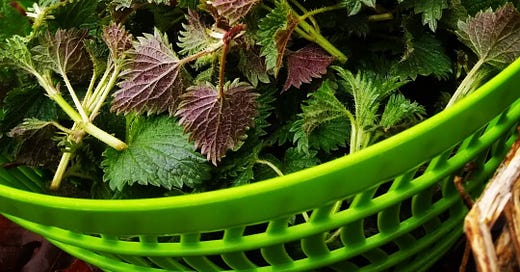




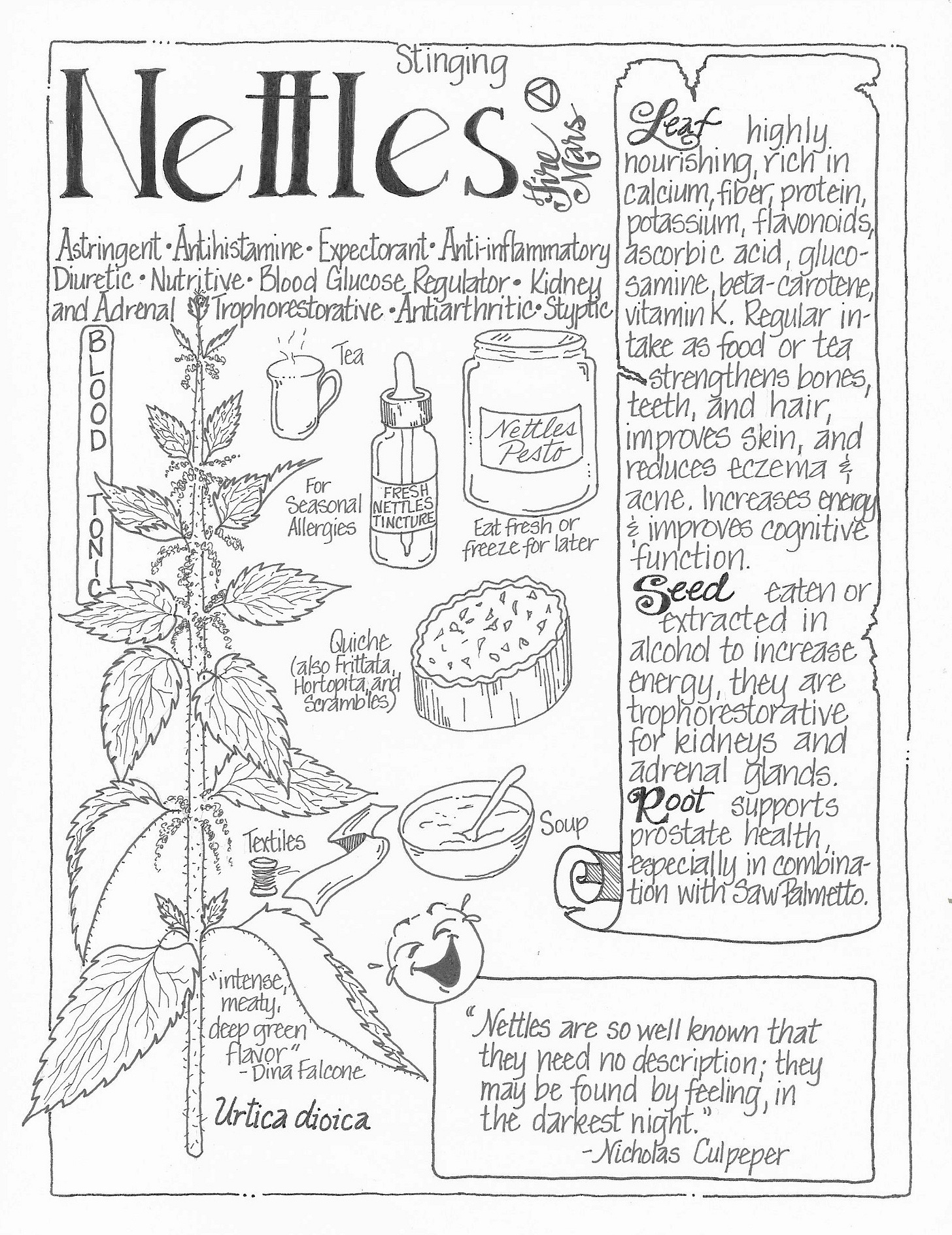
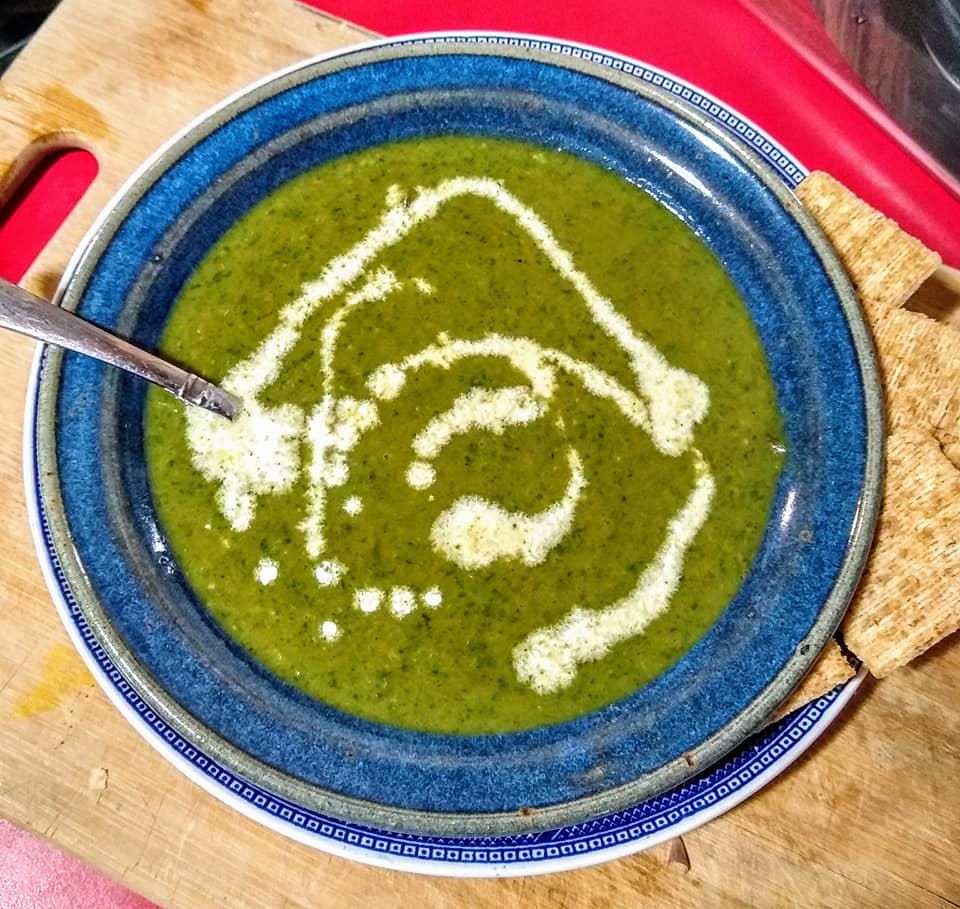
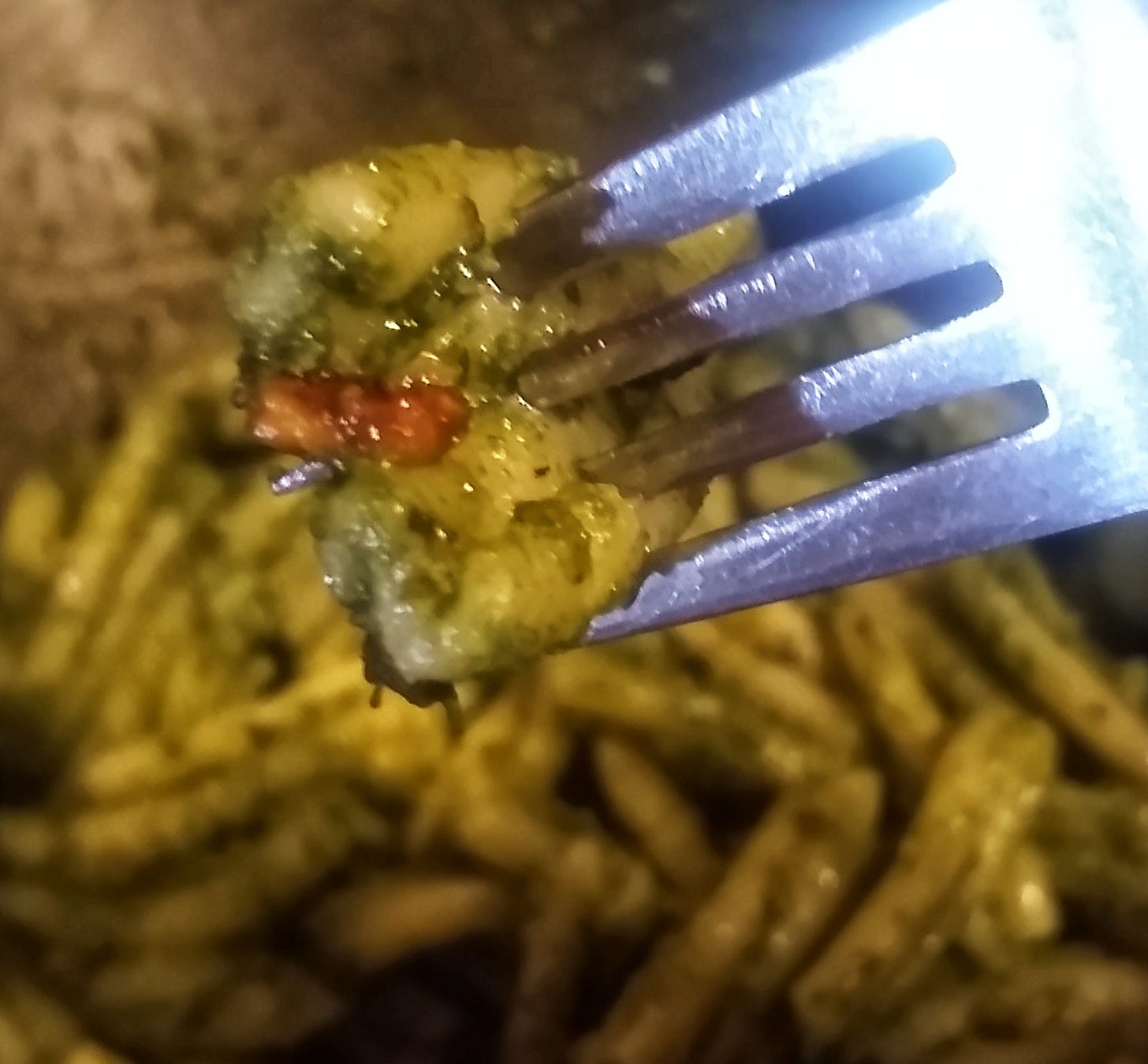
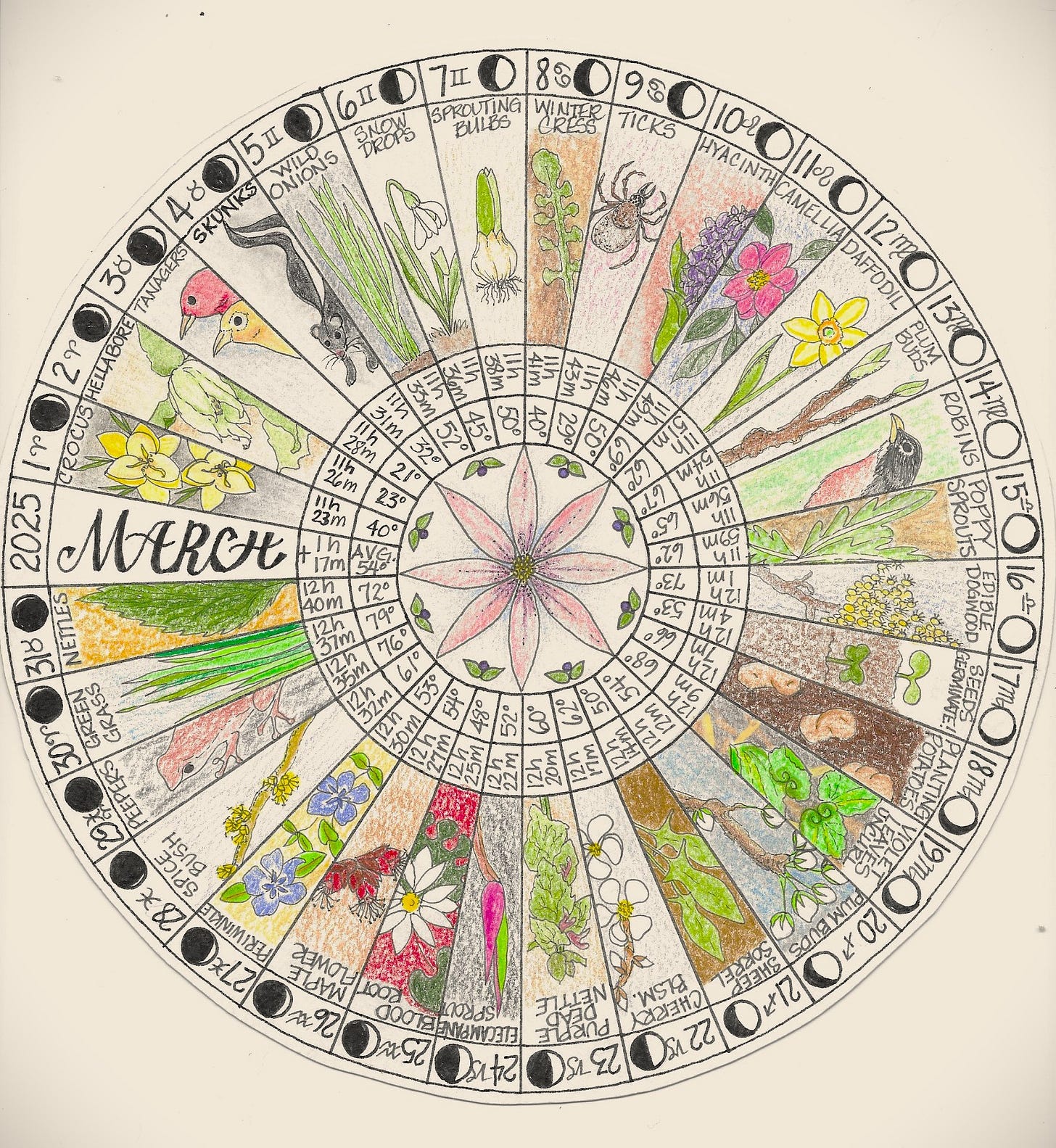
Your herb journal looks incredible!
I adore nettles & am so keen to start using them more in the kitchen this spring. This soup sounds great! 👍🏻